Wireless Sensors
The wireless sensors below are the known sensors compatible with WebIO v4.
WebIO will receive from these wireless sensors of which a total of 8 sensors
can be user registered with WebIO allowing WebIO to maintain a summary web page of
the current state of each sensor. WebIO will also keep an short internal history of
sensor readings with date time stamps for display on an internal WebIO web page.
The 8 registered sensors can also be assigned internal WebIO automation such that when
the sensors is triggered "alert/on" a defined X10 powerline (or X10 wireless or Expansion Port Relay)
command will be sent.
A sensor will also have a "normal/off" state which can also be defined to
send a command. WebIO also has a "home/unlock" and "away/lock" mode, where in lock
mode sensors marked to "alarm" will also execute an "alarm" X10 command when the sensor
is triggered into "alert/on" state.
WebIO also sends out each sensors reading over the TCP/IP network for use by the
WebIO PC automation and notification software, which can be used to send email or
text message notifications based on sensor activity.
|
|
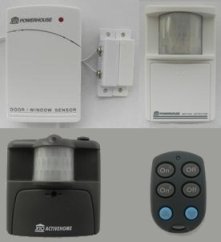
Wireless Sensors
|
The sensors below are known compatible X10 security sensors and X10 automation sensors.
It is recommended that "security" sensors are used for more critical applications
due to these sensors have an internal unique identification (ID) that uniquely indentifies
the sensor so that no other sensor can pose as the security sensor.
Unlike wireless X10 security sensors, X10 wireless automation sensors are identified
using the standard House Code/Unit Code addressing
system that powerline X10 devices use. WebIO uses the House/Unit
Code as the identifier for wireless X10 automatin sensors/remotes.
WebIO uses security senors ID's for addressing security sensors.
These wireless sensors are generally very low cost.
Many of these sensors can be purchased from Key Eleven WebIO online sales or from
other vendors on ebay or the Internet.
|
|
|
|
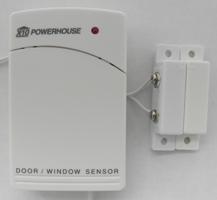
Entry Sensor - DS10A

Sensor uses:
- Door, cabinet entry sensor
- Garage door position sensor
- Tank or sump over full sensing, pump automation
- Door bell and many other creative uses
|
|
This wireless entry sensor like most entry sensors uses a magnetic reed switch
to sense entry and switch states. Typically the entry sensor and reed switch is
mounted next to a door and the magnet is mounted on the door.
When the magnet moves out of position from the reed switch, the sensor triggers
an "alarm" state. When the magnet returns into position next to the
reed switch, the sensor triggers "normal" state.
Periodically (about once per hour) the sensor sends its current state of
"alert" or "normal".
This sensor with its reed switch/magnet combination can be installed on doors, cabnets, etc.
Instead of using the included reed/magnet, you can wire other switches directly to the sensor,
for example: A mercury switch can be wired to the sensor to use as a tilt sensor, useful for
motion sensing or even used as a garage door position sensor.
Another use is to wire the sensor to a float switch to use as a sump pump over full sensor,
for turning on a spare pump, turning a warning light, and even sending you an email or
text message notification.
As yet another example, a door bell can be wired to the switch such that when the doorbell
is pressed (a normally closed doorbell) the sensor send an "alert" message, where
WebIO automation can be configured to ring an X10 chime, turn on a light and when using
the PC notification software, send a text message notifying you that the door bell was pressed.
|
|
|
|
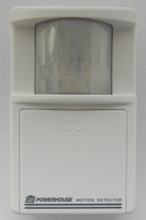
Motion Sensor - MS10A

|
|
This security motion sensor uses passive infrared sensor for sensing motion
of a human in an indoor space. Motion range up to 40 feet.
Requires 4 AA batteries.
This security type sensor uses an internal ID for addressing, it does not
send out an X10 House/Unit code for X10 automation.
But WebIO internal automation can be configured for the sensor for controlling your
X10 equipment and can be used with with the WebIO notification software.
In many cases it may be prefered to use a security sensor that transmits a unique ID
like this motion sensor, over an X10 sensor that transmits wireless House/Unit codes.
This unique ID ensures that no other sensor can "pose" as the security sensor that you
may have registered with WebIO for automation.
With wireless X10 automation sensors (which dont have an ID) you can assign the
House/Unit code that it transmits, this way you can have multiple sensors transmitting the
same House/Unit code, both acting as the same "sensor" appearing as one sensor to WebIO
(both sensors registered to the same WebIO sensor channel).
This can be useful for expanding past the 8 registered sensor limit of WebIO
(WebIO assigns sensors to 8 WebIO sensors channels).
Security sensors, having internal IDs are slightly easier to assign/register with WebIO
due to no having to first assign the sensor a House/Unit code other then the default
of A1.
Sensor uses:
- Indoor motion sensing, garage, house, office
- Automating lighting, radio, etc. on motion
|
|
|
|
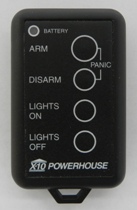
Security Remote - KR10A

|
|
This security remote is used to set WebIO into "arm/away/lock" or "disarm/home/unlock" mode.
The terms "arm, away or lock" are interchangable, all meaning that WebIO is in lock mode.
In "lock" mode, WebIO
registered sensors that are user configured as "triggering" alarm automation, will trigger
a user defined alarm automation (such as sending an X10 powerline command, X10 wireless command
or set a WebIO expansion port relay state) when the sensor enters "alarm/on" state.
The WebIO notification software can also filter notification on sensor activity based on
WebIO lock or unlock state, such that notifications can be configured to only send an email
when in lock mode.
This remote "arm" button places WebIO into Lock mode, the "disarm" button places WebIO in Unlock mode.
Currently in WebIO v4.0, only the KR10A and SH624 remotes can change WebIO's "lock/unlock" state.
Note: The KR10A remote "light" buttons dont function with WebIO v4.0. Also, this remote is a bit
"bulky" compaired to the KR19A.
Note: To use this remote (like any other wireless sensor) with WebIO, this sensor must be
registered to 1 of 8 WebIO sensor channels.
Sensor uses:
- Change WebIO lock/unlock state
|
|
|
|
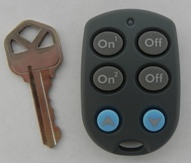
Wireless X10 Remote - KR19A

|
|
This wireless remote has 2 pairs of "On/Off" buttons that can be assinged
to a sensor channel on WebIO.
WebIO automation can then be assigned to each remote button to cause WebIO to send
a user defined X10 powerline command,
wireless command or expansion port relay state when a button is pressed.
Each button press is also sent over the TCP/IP network to the
WebIO notification and automation PC software
and/or the KE iHome Internet Portal Service for notification and/or more advanced automation.
This wireless remote transmits X10 House/Unit/Command Codes that are received by WebIO,
but the remote messages are also received by X10 wireless receivers (TM751 and RR501) which relay the
remotes wireless House/Unit/Command to the powerline for turning on/off X10 modules.
This remote's House and Unit codes are by default set to House "A" and Unit "1" and "2"
the Command/Funtions are "on" and "off".
The House and Unit codes can be changed by configuring the remote.
This remote is highly recommended for enhancing your control network, its low cost,
small and reliable.
Note: To use this remote (like any other wireless sensor) with WebIO, this sensor must be
registered to 1 of 8 WebIO sensor channels.
Sensor uses:
- Control WebIO automation
- Turn on/off lights, appliances
- Control WebIO expansion board relays
- Send an email or text message at a press of a button
|
|
| Wireless X10 Motion Sensor |
|
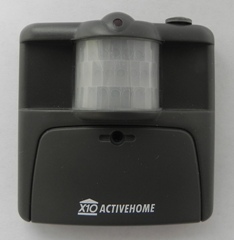
Wireless X10 Motion Sensor - MS14A

Sensor uses:
- Motion control of WebIO automation
- Turn on/off lights, radio, etc. on motion
- Control WebIO expansion board relays
- Send an email or text message on motion
|
|
This small indoor/outdoor battery powered wireless motion sensor
transmits an X10 "on" command when motion is detected and transmits an "off"
command when motion has not been detected for an amount of time.
This sensor can be assigned to 1 of 8 WebIO sensor channels for automation of
X10 powerline, wireless and expansion port relays.
Due to this sensor transmitting X10 house/unit/command it can also be received
by X10 receivers (TM751 and RR501) that relay the signal to the powerline to control X10 modules
without WebIO.
This sensor's house and unit codes are by default set to house "A" and unit "1",
the command/funtions are "on" and "off".
The house and unit codes can be changed by configuring the sensor.
This motion sensor also has built in timer functions and dusk/dawn funtions.
Unlike the MS10A security motion sensor, the MS14A does not have an ID, instead it
is addressed by WebIO using its assigned house/unit code.
This allows more than 1 MS14A to share the same WebIO sensor channel, although
the sensors sharing a channel cannot be distiguished from each other by WebIO.
Configuring the house/unit address of this sensor is a rather tedious, where as the
"bulkier" MS10A sensor uses an internal ID instead.
This small low cost and more elegant looking sensor (compaired to the MS10A) requires 2 AAA batteries.
Note: To use this remote (like any other wireless sensor) with WebIO, this sensor must be
registered to 1 of 8 WebIO sensor channels.
|
|
|
|